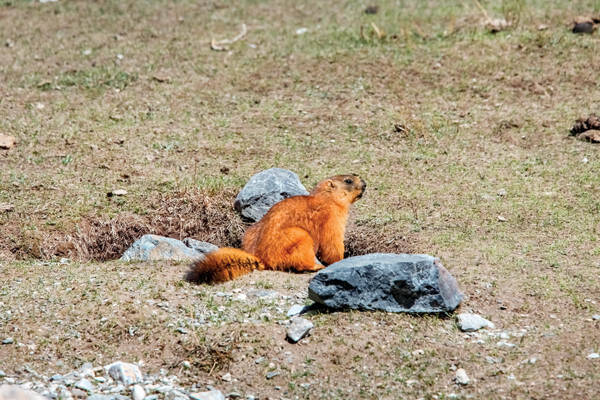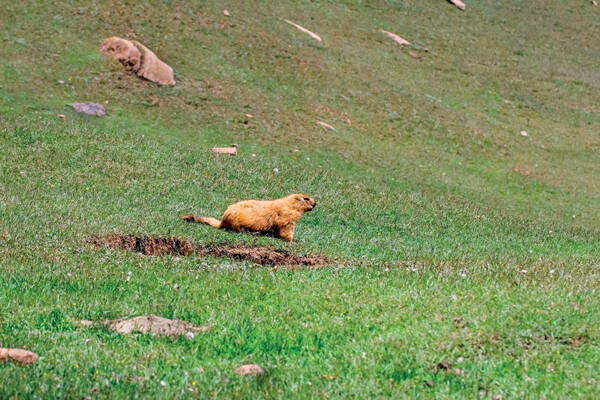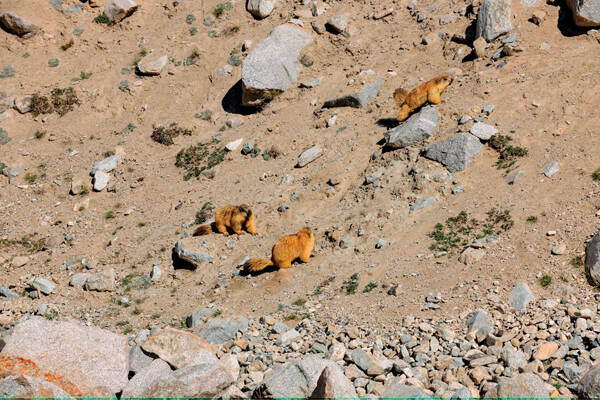Marmota caudata
IUCN
LCBasic Information
Scientific classification
- name:Marmota caudata
- Scientific Name:Marmota caudata,Long-tailed Marmot,Red marmot, Marmot
- Outline:Rodents
- Family:Rodentia Sciuridae Marmota
Vital signs
- length:Approx. 530 mm
- Weight:
- lifetime:
Feature
The tail is the longest among all marmots, exceeding half the length of the body. The fur on the back and sides is brown-red, so it is also called the red marmot.
Distribution and Habitat
Distributed in western Xinjiang in China. Distributed abroad in Pakistan, Afghanistan and Central Asia.
Mountain squirrels mainly live in open and rocky areas in coniferous forest habitats, and like to move on dry hillsides with short grass.
Appearance
The body is stout, with a tail nearly half the length of the body, and the hair on the back is long. The body color ranges from rust yellow to rust orange. The back is mixed with dark brown. The top of the head is black or dark brown. The abdomen is similar to the back color, slightly darker orange, without brown. The color of the back of the tail is similar to the back of the body, and the hair on the tip is brown to black. The snout is short and wide. The nasal bone is short, and the rear end does not go beyond the front edge of the eye socket. The auditory bulla is small. The length of the interdental space is slightly larger than the length of the upper cheek teeth.
Details
The long-tailed marmot is a large terrestrial rodent of the Sciuridae family and the genus Marmota. It is slightly smaller than the gray marmot, and has the longest tail among all species of the genus Marmota, averaging about 38% or half of the body length. The fur is long and fluffy, rough and less shiny. The entire body and limbs are almost all rusty red or brownish yellow. It lives on the edge of the alpine bare rock ice and snow cold desert zone at an altitude of 2800-4500 meters, and its habitat is very narrow. In Xinjiang, China, its vertical distribution range is mostly in the subalpine and alpine meadow grasslands at an altitude of 3500-4500 meters. In some areas, it can descend to 3200 meters along the river valley, or rise to the edge of the alpine bare rock ice and snow cold desert zone at 5000 meters. The most favorable habitat for them is the true grassland with relatively well-developed grasses of the Gramineae family at 3500-4000 meters (in Wuqia) or 3900-4300 meters (in Taxkur).

Long-tailed marmots like to build caves in river valley terraces with thick soil and rich vegetation and at the foot of gentle slopes, and live in family-style groups. The cave group consists of living caves and temporary caves. The living caves are divided into three types: hibernation caves, summer caves, and winter and summer caves. The tunnel is slightly more complex than that of the gray marmot, deeper and longer, with 4-5 entrances. The tunnel is 2-3 meters deep, and the length is mostly over 30 meters, and the longest can reach over 50 meters. The tunnel is tortuous and complex, with many cave chambers, and the nest is located at the end of the tunnel. The temporary tunnel is short and shallow, without branches, and there is no nest.
The long-tailed marmot is active on the ground for about 5 months, that is, it usually comes out of hibernation in mid-April and begins to hibernate in early September. It is a typical diurnal species, and is very active almost throughout the day, but the ground activities are most active at 7-10 am and 5-8 pm. There are two peaks of activity per day. The long-tailed marmot feeds on the stems and leaves of various forage grasses, and also eats some immature plant seeds and a small amount of insects in autumn.

Long-tailed marmots mate in caves before emerging from hibernation. When emerging from hibernation, most female otters are already pregnant, or even in the second trimester of pregnancy. Young otters appear on the ground in late May and early June. They reproduce once a year, with 2-4 cubs per litter, and 5 cubs are rare. Long-tailed marmots also reach sexual maturity relatively late, generally at the age of 3. That is, they are only able to reproduce in the third or fourth year after birth. Adults only account for almost half of the entire population. Among the female adult otters, at least half or more of them participate in reproduction every year. Its population dynamics and population status may be similar to those of the gray marmot.
The long-tailed marmot is an economic animal that combines fur, meat, and medicine. The fur is solid and wear-resistant, elastic and warm, and the guard hair is neat and shiny, with rich plush. It can imitate a variety of precious furs such as otters, minks, and sables. It is a high-quality raw material for making furs, clothes, hats, and shawls; the tail hair and guard hair can be used to make various high-end paintbrushes, instrument brushes, etc. The long-tailed marmot produces a lot of meat. Otter meat is a high-protein food with tender meat. It is a game delicacy at high-end banquets and can also be made into feed. Each long-tailed marmot can produce an average of about 1 kg of oil. The solidification point of marmot oil is -6℃. It can be used to make high-grade lubricating oil, and it can also be eaten. It is also the raw material of high-grade cosmetics. The oil can be used externally to treat arthritis, burns, scalds, frostbite, etc., and it has the effect of removing blood stasis and stopping bleeding when taken internally. It is also effective for anemia, tuberculosis and other diseases. The heart, liver, gallbladder, claws, etc. of the long-tailed marmot can also be used as medicine, which has the effect of curing diseases and nourishing.

Ecological harm: The long-tailed early otter lives in good pastures, digs holes in the grasslands to build nests, eats high-quality pasture grass, and has a large appetite, which is very harmful to pastures and animal husbandry, and is a grassland pest.
Relationship with epidemic diseases: Long-tailed marmots are the main host of Luo, the natural plague source of long-tailed marmots in the forest steppe of the Pamir Plateau, and are also the main storage host of the Saretash plague source in Kyrgyzstan bordering the Wuqia Mountains in China. In addition, Q fever serology positives have been detected for the pathogens of anthrax and lanceolate fluke disease.








